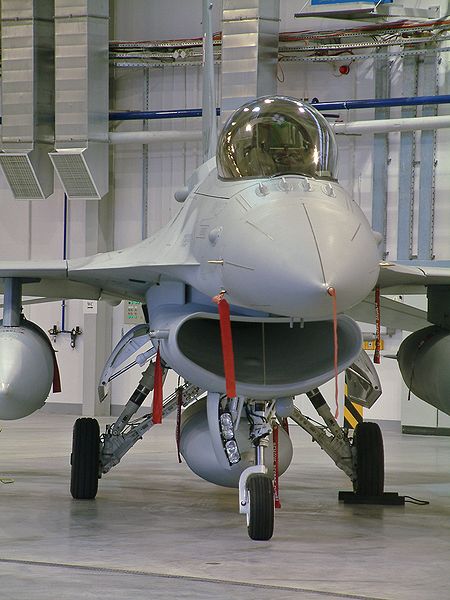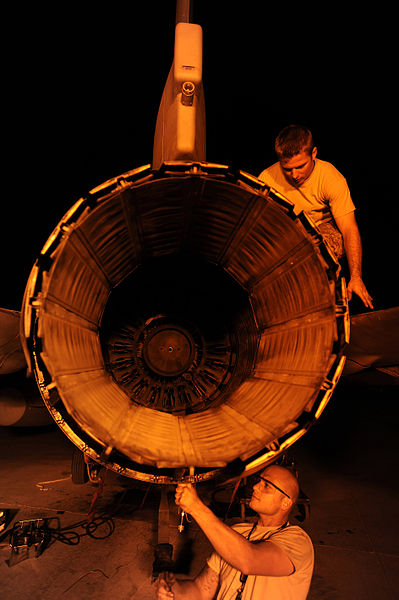NOTE: visit www.techenlife.com for more details regarding this blog and military aviation!!
Since i have passed my junior school, i have been a great fan of this brilliant machine.
F-16 is my all time favorite combat aircraft. I have a dream to fly his beast once in my life.
Known as a “Viper” among the fighter pilots, F-16 Fighting Falcon is a dogfighter with numerous innovations including a frameless bubble canopy for better visibility, side-mounted control stick to ease control while maneuvering, a seat reclined 30 degrees to reduce the effect of g-forces on the pilot, and the first use of a relaxed static stability/fly-by-wire flight control system that makes it a highly nimble aircraft. The F-16 has an internal M61 Vulcan cannon and has 11 hardpoints for mounting weapons, and other mission equipment.
With a MAX speed of over mach 2, F 16 can get into enemy’s territory in no time.
The F-16 is a single-engined, very maneuverable, supersonic, multi-role tactical aircraft. The F-16 was designed to be a cost-effective combat “workhorse” that can perform various kinds of missions and maintain around-the-clock readiness. It is much smaller and lighter than its predecessors, but uses advanced aerodynamics and avionics, including the first use of a relaxed static stability/fly-by-wire (RSS/FBW) flight control system, to achieve enhanced maneuver performance. Highly nimble, the F-16 can pull 9-g maneuvers and can reach a maximum speed of over Mach 2.
Early models could also be armed with up to six AIM-9 Sidewinder heat-seeking short-range air-to-air missiles (AAM), including a single missile mounted on a dedicated rail launcher on each wingtip. Some variants can also employ the AIM-7 Sparrow medium-range radar-guided AAM, and more recent versions can be equipped with the AIM-120 AMRAAM. It can also carry other AAM; a wide variety of air-to-ground missiles, rockets or bombs; electronic countermeasures (ECM), navigation, targeting or weapons pods; and fuel tanks on eleven hardpoints – six under the wings, two on wingtips and three under the fuselage.
The F-16 design employs a cropped-delta planform incorporating wing-fuselage blending and forebody vortex-control strakes; a fixed-geometry, underslung air intake inlet supplying airflow to the single turbofan jet engine; a conventional tri-plane empennage arrangement with all-moving horizontal “stabilator” tailplanes; a pair of ventral fins beneath the fuselage aft of the wing’s trailing edge; a single-piece, bird-proof “bubble” canopy; and a tricycle landing gear configuration with the aft-retracting, steerable nose gear deploying a short distance behind the inlet lip. There is a boom-style aerial refueling receptacle located a short distance behind the rear of the canopy. Split-flap speedbrakes are located at the aft end of the wing-body fairing, and an arrestor hook is mounted underneath the aft fuselage. Another fairing is situated at the base of the vertical tail, beneath the bottom of the rudder, and is used to house various items of equipment such as ECM gear or drag chutes. Several later F-16 models, such as the F-16I variant of the Block 50 aircraft, also have a long dorsal fairing “bulge” that runs along the “spine” of the fuselage from the rear of the cockpit to the tail fairing; these fairings can be used to house additional equipment or fuel
The F-16 was the first production fighter aircraft intentionally designed to be slightly aerodynamically unstable.[43] This technique, called “relaxed static stability” (RSS), was incorporated to further enhance the aircraft’s maneuver performance. Most aircraft are designed with positive static stability, which induces an aircraft to return to its original attitude following a disturbance. This hampers maneuverability, as the tendency to remain in its current attitude opposes the pilot’s effort to maneuver; on the other hand, an aircraft with negative static stability will, in the absence of control input, readily deviate from level and controlled flight. Therefore, an aircraft with negative static stability will be more maneuverable than one that is positively stable. When supersonic, a negatively stable aircraft actually exhibits a more positive-trending (and in the F-16’s case, a net positive) static stability due to aerodynamic forces shifting aft between subsonic and supersonic flight. At subsonic speeds the fighter is constantly on the verge of going out of control.
The F-16A/B was originally equipped with the Westinghouse AN/APG-66 fire-control radar. Its slotted planar-array antenna was designed to be sufficiently compact to fit into the F-16’s relatively small nose
In short, Viper or Fighting Falcon is a legendary generation 4.5 aircraft which is the most advanced and technically sooper dooper machines of its era..







perfect information!
glad you like it 🙂
Pingback: The Legendary F-16 Fighting Falcon (via My Wardrobe) « Calgary Recreational and Ultralight Flying Club (CRUFC)
Pingback: 4th generation jet fighters | My Wardrobe
Pingback: The Legendary F-16 Fighting Falcon (via My Wardrobe) « Sercan
thanks for visiting my blog. An interesting blog to visit 🙂
Pingback: 4th generation jet fighters
Pingback: 4th generation jet fighters | Tech EN Life